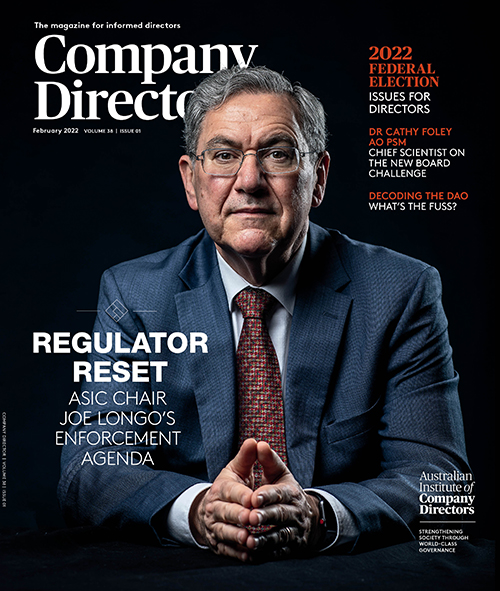Tech giant Adobe hopes that its first global advisory board will enhance its relationship with customers and open up new opportunities.
Patrick Allaway, chair of the Bank of Queensland and a director of Nine Entertainment and Dexus, recently added another role to his board portfolio — member of the global advisory board of tech giant Adobe. It’s a very different role from the usual governance and oversight responsibilities that come with a seat on a statutory board.
“There’s no governance and fiduciary responsibility and that’s fantastic,” says Allaway. “It’s so nice to turn up to meetings and not focus on governance, but to focus on the business and the customer — to focus on the customer experience and providing solutions that create better experiences for customers.”
As its name suggests, the role of the Adobe International Advisory Board is purely consultative. It aims to bring in expertise from the industries that Adobe’s key customers inhabit as well as from different geographic areas. Its seven members are current or former chief executives or chairs from the banking, retail, consumer goods and manufacturing sectors across Asia and Europe.
While Adobe has expertise in its own domain of technology, the advisory board provides it with the customer perspective and local market knowledge that it lacks, says Allaway.
“For example, if they’re about to pitch to a financial institution with that proposal [the board provides] some insights in relation to that industry, the key messages and how they should structure the proposal are areas that they need support on.”
The advisory board also provides introductions and open doors to boardrooms and the C-Suite. “All of the advisory board members have been through major digital transformations in their past and have experience in digital transformation, so it’s helping Adobe support boards and senior executives on that journey and providing insights from those experiences on the journey,” says Allaway. “Those experiences are absolutely gold [in helping] as boards and CEOs and groups go through these digital transformations.”
Outside perspective
The advisory board meets once every three months, to discuss strategy and insights around the value proposition that Adobe brings to its customers and how it delivers that. It provides feedback on industry trends in Europe and the Asia Pacific and on what Adobe could be doing differently — reporting to Paul Robson, the head of Adobe’s San Jose, California- headquartered international business and chair of the global advisory board.
The more active role for members of the board is to interact with the local team, advising and sometimes mentoring them. Allaway talks with Adobe Asia Pacific president Simon Tate about once a week and regularly meets with Adobe ANZ vice president and managing director Suzanne Steele in relation to proposals they are putting together and their customer approach. The role provides a lot more freedom to interact directly with team members and work with them with customers on enunciating the Adobe value proposition, in a way that the separation of the roles of management and traditional boards might not.
In fact, there is no crossover of responsibility with the main Adobe board. “We have no authority at all,” says Allaway. “We can’t hold management to account. We don’t appoint and sack the CEO or have any say in the senior leadership team. There’s no oversight role at all.”
The Nasdaq-listed Adobe has a market capitalisation of about US$320b (November 2021) and earned revenue of US$12.9b in FY20. It is probably best known for its Photoshop digital imaging and Acrobat PDF creating/editing programs, but a central focus for the company now is in providing software to help organisations digitise and improve their customer experience.
Sydney-based Tate says that while Adobe already had strong brand recognition among Australia’s major corporations, it wants the board to accelerate brand advocacy at the senior and board levels of companies — which he refers to as “the last mile sponsorship”. “What we really needed by way of the advisory board were people who understood digital transformation from a customer’s perspective,” he says. “We certainly understood it from a technology and partnering perspective, but we needed people who understood what digital transformation looked like through the lens of the C-Suite and the boards of banks, manufacturers and retailers. Just having that outside-in perspective has been really interesting, because it’s completely changed our approach and our narrative on where we think we can add value to most of these companies.”
Customer focus imperative
The advisory board members are helping to position Adobe among corporate leaders as being central to their growth ambitions as they digitise and focus on customer experience.
Apart from his current board roles, Allaway has in the past sat on the boards of Fairfax, Metcash, David Jones and Macquarie Goodman, and is a former executive at Swiss Banking Corporation (now UBS).
“Where we lean on Patrick is as much around that last mile sponsorship into the C-Suite and the board of directors, but also for Patrick to come to us and say, “Hey Adobe, you need to turn up a little bit differently on this issue or that issue,” says Tate. “He has a perspective that, despite our incumbency, it has been a little difficult for us to tap into — just by the nature of the network that he has with the people he interacts with.”
Tate cites the issue of mortgage “churn” — where home loan customers switch banks — as an example of where the advisory board has provided insight. Banks can only meaningfully increase their mortgage books if they take customers from other banks, because the increase in new home loans is not enough to sustain the sort of growth the banks are seeking. In such an environment, reducing customer loss becomes a form of growth.
“That scenario when you turn that mortgage churn reduction into dollars for most banks in Australia is worth hundreds of millions of dollars, which goes straight to the bottom line,” says Tate. “Up until we had Patrick and others on our international advisory board, I wouldn’t say we had no idea, but we didn’t understand the magnitude of the problem that represented to the industry.”
Along with Allaway, the advisory board includes among others: Zurich-based Barbara Kux, a multiple board director with executive experience in consumer goods and industrial companies; world- renowned economist Professor Heizo Takenaka, a former Minister of Economic and Fiscal Policy and Minister of Financial Services in Japan; and German- based Dr Dieter Zetsche, chair of the supervisory board of tourism giant TUI AG and a former chair of Daimler.
Being a member of such a diverse board has Allaway thinking that Australian boards could bring more external and diverse expertise into the boardroom. In March, the BOQ board added Los Angeles-based Mickie Rosen, who has director and executive experience with US media companies and is also a director of Nine Entertainment.
“She brings a very different perspective to what you would get from a traditional Australian board — who all come from the same schools, universities, backgrounds,” says Allaway.
The Adobe International Advisory Board is less than 12 months old, but Tate says that given its success so far, it’s a model Adobe will stick with. And it’s a role that Allaway will continue to enjoy. “That’s a great part of the role,” he says. “We have freedom of not having that responsibility — where we can dig into what really matters.”
Advisory board explainer
Advisory boards are a group of people who, as the name suggests, give advice, recommendations or counsel to a business or other organisation.
Investment banks in Australia often have an advisory board, but beyond that they are rare. In Europe and the US, where corporate boards have a much higher proportion of executive members, they are more common.
They have no ability to make binding decisions and no governance or oversight responsibilities.
As a result, says Patrick Allaway, chair of the Bank of Queensland, a director of Nine Entertainment and Dexus, and a member of the global advisory board of Adobe, their members aren’t chosen for the governance skills. “For an advisory board, you’re actually looking for people who come from industries that reflect your target customers,” he says. “The focus is all around the customer and insights in relation to the customer.”
In its advice on advisory boards, as part of its director tools, the AICD says the terms of an advisory board’s remit, constitution, function, accountability and responsibility should be set out in a documented charter or terms of reference. “Care needs to be taken that advisory board members, by the structure of their office and functions or by the practice of the performance of their role, do not become de facto or shadow directors with the attendant additional duties, responsibilities and personal liabilities involved for a director of an organisation,” states the AICD.
Allaway agrees. “What’s really important is that you don’t cross the line and undermine the fiduciary responsibility of directors,” he says. “Make sure there’s a clear delineation between the role of the board and what you would expect from an advisory group.”
Many statutory boards in Australia would find the structure challenging and would question why the company needs the capability, he says. “Management would love it, because it gives lots of insights and provides a greater depth than you get from your [regular] board."
Latest news
Already a member?
Login to view this content



